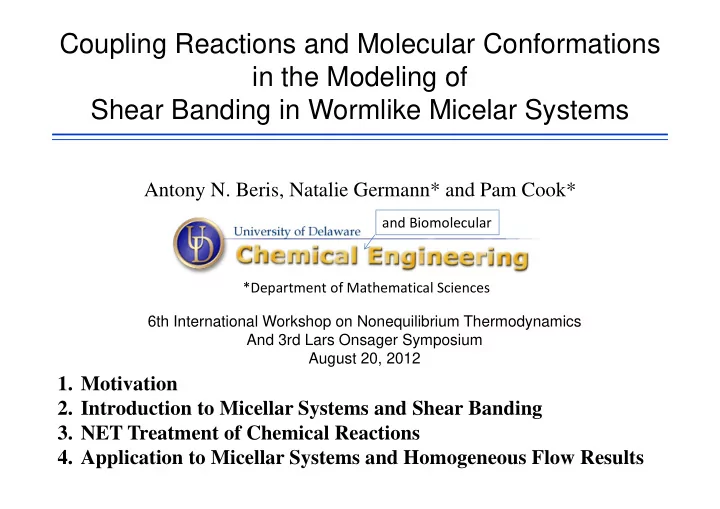

Coupling Reactions and Molecular Conformations in the Modeling of Shear Banding in Wormlike Micelar Systems Antony N. Beris, Natalie Germann* and Pam Cook* and Biomolecular *Department of Mathematical Sciences 6th International Workshop on Nonequilibrium Thermodynamics And 3rd Lars Onsager Symposium August 20, 2012 1. Motivation 2. Introduction to Micellar Systems and Shear Banding 3. NET Treatment of Chemical Reactions 4. Application to Micellar Systems and Homogeneous Flow Results
New Application: Rod-like Micellar Systems
Micellar systems: concentrated suspensions of surfactants Concentration CMC
Rodlike Micellar Systems: Shear-Banding
Previous Models for Rodlike Micellar Solutions
Current Approach Extends VCM under NET
VCM Central Concept: A -> B Reaction Number Densities: n N ; n N A B M M A A B A A B Conformation Tensor Densities: C n c ; C n c ; c Q Q A A A B B B i i i Q Q is the second moment of the end ‐ to ‐ end connection vector, Q , for component i i i i Momentum Density: M = v ; = A B S
General reaction kinetics in multicomponent systems • Assume that the system: involves n components, optionally with internal structure and • participates in I chemical reactions • For each component, i = 1, 2, … n , the following primary variables are defined: • the mass density, ρ i • the momentum density, m i , m i = ρ i v i • (optionally) the internal structural tensor parameter density, C i , C i = n i c i • where: i v is the mass ‐ based velocity of component i n N is the number density of component i i i M A i i i i i c is the conformation tensor of component ; i c Q Q i i i Q Q is the second moment of the end ‐ to ‐ end connection ve ctor, Q , for component i
NET Extension for Chemical Reaction Rates • It preserves standard transition theory kinetics that assigns for the corresponding forward (-) and reverse (+) flux of the reaction I , an Arhenius dependence on the corresponding affinity: exp A I J k P T , I I RT • However, a generalized affinity is proposed in order to also accommodate other, nonequilibrium, changes associated with the reaction I , such as momentum and conformation (for entropy one needs a more general (GENERIC) formulation): k k C n H m H H A M I Ik k k k m C k 1 k k k G H where represents the Galilean invariant contribution: k m G n H H H H H k m v v k k k m m m m m m m 1 G
Corresponding Dissipation Bracket* k k C F m F F k k m C k k k G n F H , J M k k n C m I Ik k 1 F F F I M k 1 Ik " k " n k " k " m C k " 1 M k " k k G Ik ' k ' k ' 1 k k C F m F F k k m C k k k G n J M k k n C 1 F m F F I Ik k M k 1 Ik " k " n k " k " m C k " 1 M k " k k G Ik ' k ' k ' 1 • It duly satisfies Onsager’s reciprocity relations • It does not affect the overall momentum equation • It redistributes among the products the excess momentum and conformation * to within an entropy correction term, not needed for isothermal processes
NET Implementation for Homogeneous Micellar System
Key Element: Dissipation Induced by the Reaction
Final Equations
Comparison with the VCM Model
New Model Predictions
Model Non-Dimensionalization & Parameters
Homogeneous Shear Flow Predictions -1
Homogeneous Shear Flow Predictions -2
Comparison Against the VCM Model - 1
Comparison Against the VCM Model - 2
Three-Species Model Non-dimensionalization Time : Length: Pressure: Number density: Conformation: Stress: Dimensionless numbers Viscosity ratio: Ratios of relaxation times: Reaction rates:
Three-Species Model: Planar Couette Flow
Three-Species Model: Planar Couette Flow
Three-Species Model: Planar Couette Flow
Conclusions • We have corrected and significantly extended the description within NET that first appeared in our previous work [Beris and Edwards, 1994] of chemical reactions taking into account momentum and (for systems with internal structure) conformation transfers during each elementary reaction • The new description allows for reaction rates that are conformation-dependent: - This can explain some very recent experiments on DNA scission under extension [Muller et al., ICR Lisbon, 2012] - The new description has been applied to the modeling of a system of concentrated rodlike micelles: • The new model produces very similar, non-monotonic shear stress vs. shear rate, predictions for homogeneous shear flows, while being thermodynamically consistent and requiring fewer parameters • The new model can be easily extended to more physically realistic situations (for example, allowing for a third species) • Future work: Extension of the model to nonhomogeneous flows, along the lines of a multifluid approach in order to simulate shear-banding phenomena.
Acknowledgments Prof. Norman J. Wagner (UD, C&B Engineering) Prof. Hans Christian Oettinger (ETH, Zurich)
Additional Slides
Two-Species Model: Uniaxial Extension
Two-Species Model: Uniaxial Extension
Cylindrical Couette Flow*: Shear Banding! * Preliminary results based on simplified diffusion model
Recommend
More recommend